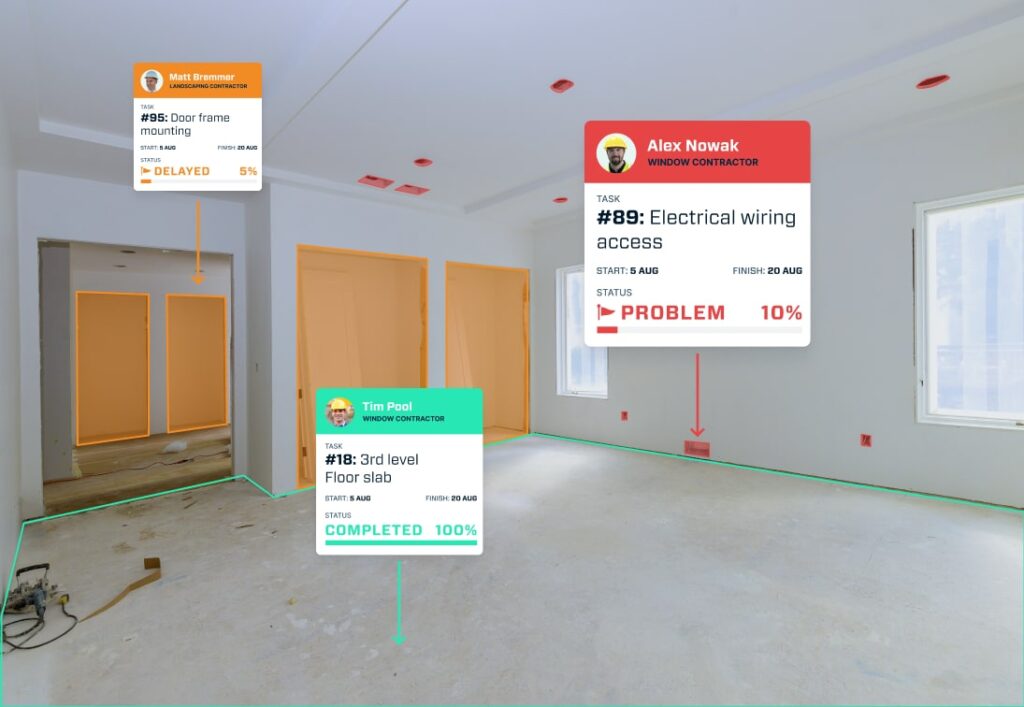Keeping track of what is happening on site is challenging if you don’t have the right tools to help you. Especially when it comes to your snagging and QHSE processes which for many project managers, site foremen, and QHSE managers are synonymous with excessive administrative workload and a lot of stress and frustration. The result?
- Information overload and milestone misalignment
- Increased waiting time between tasks
- Non-conformities are discovered during handovers
- Never-ending disputes that put your margins in danger
This is why giving your site teams access to the documents and drawings they need at any time even when you are not on site is so crucial.
Free ebook: Why WhatsApp and Excel aren’t enough for running complex construction projects
From the Quality Control Plan to the collection of final handover remarks, including Health, Safety, and Environment observations, teams on the field should be able to submit their follow-ups and questions in real time so that problems can be escalated quickly.
Like that, you can prevent mistakes before they become a threat to your project and deal with evolving challenges more effectively.
However, in order to bring this dynamic and admin-light approach to life, you need to digitalise your snagging and QHSE processes by implementing tools that are specifically made for construction teams.
WhatsApp, messenger, emails, or even phone calls might allow you to share information with other stakeholders (both internally and externally) but they don’t give you the overview you are in need of to act fast and see everything on site at all times. Let alone that all the updates that you share in this way can’t be linked to your 3-6 week lookaheads and your master schedule.
As a result, even if you have shared an update with the right person at the right moment you are unable to fully understand its impact on the existing dependencies of the project turning decision making into a slow and cumbersome process.
What paper-based QHSE and snagging looks like
Before we dive deeper into how you can digitalise your QHSE and snagging processes, let’s take a closer look at the problems that may appear if you choose to rely on pen and paper or the wrong digital tools for managing quality and safety on your projects.
More specifically, here are some of the biggest pains that many of our customers were battling against before they embark on their digital transformation journey:
Too many tools to handle
The more tools the better, right? Well, you might want to think again. The multiplicity of tools is one of the main obstacles for efficient and admin-free QHSE and snagging processes. The reason for this is that most of the implemented tools aren’t connected with each other in real time.
Learn more: How to place planning at the centre of your projects to protect your margins and deliver faster
This lack of connectivity means that depending on which tool you are using you have access to a different, and often distorted, version of reality. Given also the vast amount of data that is generated every day on site, from a point and then it becomes impossible to tell what the actual state of your project is.
So you can quickly find yourself lost in a sea of disconnected information unable to trace and resolve constraints or find the information you need to raise or respond to a claim.
Admin-heavy processes
Many project managers tell us they use up to 40% of their days on creating project reports, jumping from one meeting to another, and chasing people on the site for updates. For many of them, it doesn’t take long before they:
- get buried in details and miss the full picture.
- can’t focus their attention on getting the project going.
- have no time to focus on tasks that really matter.
- get overwhelmed by stress.
And this is how they end up wasting both time and energy on issues and requests that shouldn’t be a thing in the first place.
Difficulties in following up on QHSE non-conformities
Having an easy way to verify what’s not been done even if you are not able to go on site yourself is of paramount importance for the success of your project. However, many project managers are still struggling with consistently getting an accurate picture of what’s happening on site.
The reason is again the absence of a real-time connection between site checks and the project’s schedule. This limited view of the reality on the field gives both internal and external stakeholders a wrong idea of the achieved progress fueling downtime between activities.
For instance, subcontractors might appear on site in vain because another task hasn’t been successfully closed out or handovers might be delayed because the QHSE manager discovered a non-conformity literally at the very end of the whole process.
How to connect your QHSE and snagging processes
Taking all this into consideration, it comes as no surprise that more and more players in construction are actively looking for a way to create a live, shareable link between their quality management and their project planning processes.
In that way, they will be able to get rid of unnecessary admin work and constant stress by having everyone working on the same wavelength. If you are also after the same results, this is how you can make it happen:
1. Use a single source of truth
Your quest for better and more efficient QHSE and snagging processes begins from moving all project information to a central tool in the cloud. By making all recorded data available to all relevant parties in a live, shared location you ensure that everyone involved in the project has the same view as you. Like that, the collaboration between teams is considerably improved as all stakeholders face the same direction and have a better understanding of what are the milestones and constraints that need to be tackled next.
Read also: 5 tips that every site foreman should know about
Furthermore, by introducing a single source of truth to your projects you reduce your administrative workload as you no longer have to look in a million places for collecting the latest feedback from the site. Now, everything is available in one place and you have the overview you need to react to problems as soon as they appear.
And that’s not all! The fact that all information is now stored in the cloud allows you to raise or respond to claims much faster. You will no longer have to spend days or even weeks to find that one photo or email that proves you are not responsible for a setback on the project’s schedule. With just a quick date or task-based search, you will be able to gain access to the information you need in order to safeguard your project from interruptions and additional costs.
2. Implement construction-specific tools
We have already mentioned the importance of choosing a tool that is made for construction teams. Only then, you can feel sure that your schedule reflects reality at any given time. All communication will take place in a single data source allowing you to connect effectively with multiple project stakeholders so that you can make the right decisions faster and plan your next steps with confidence.
For instance, a construction-specific tool would allow you to:
- guarantee transparency in your projects and help all employees keep track of any changes to the site in real time.
- easily add new snags using photos, comments, and annotations on the latest version of the plan. With an exhaustive view of all current and future snags, improve visibility and communication on your site.
- have all your field reports, forms, and checklists on your tablet.
- collect accurate information through an automated checklist process.
- standardise all your forms and define a clear and easy workflow for all your projects.
And more importantly, the impact of all information that arrives from the field is instantly visible on the different schedules that you are working on. Like that, you continuously maintain a live overview of where you stand in the project without even having to leave your office.
At the same time, your people on site can effortlessly document progress and submit updates of critical importance just by using their mobile device.
With everyone being kept in full sync, it becomes easier for you to avoid mistakes and deliver successful projects faster and cheaper.
3. Clearly define when a task is completed
Do you know when a task in your project is really “done”? Waiting for other subcontractors or team members to complete their tasks is one of the main reasons behind delays and downtime in construction. How could you avoid that? By having a clear, standardised set of rules and practices regarding when a task should be considered closed.
This is the key to aligning the expectations of all team members and avoiding mistakes. When should a handover be considered successful? When is the right time for the next material order to arrive on site? And where?
These questions might sound simple but on a construction site can be the fuel for delays, interruptions, or even commercial claims that put your margins at serious risk. This is why project managers and everyone else involved in a project need a single, central, and live view of short-term planning.
And this is also why you want to connect your quality management processes to your master schedule so that you can always feel confident that all work done on site lives up to the specifications defined before the beginning of the project.
Track more. Manage better.
If you also want to regain control and connect your teams under a live schedule in a single source of truth, it’s time to say goodbye to tools that are holding you behind like WhatsApp, MS Project, and Excel. Download our free ebook and see how you can digitise and automate your quality and safety processes.




